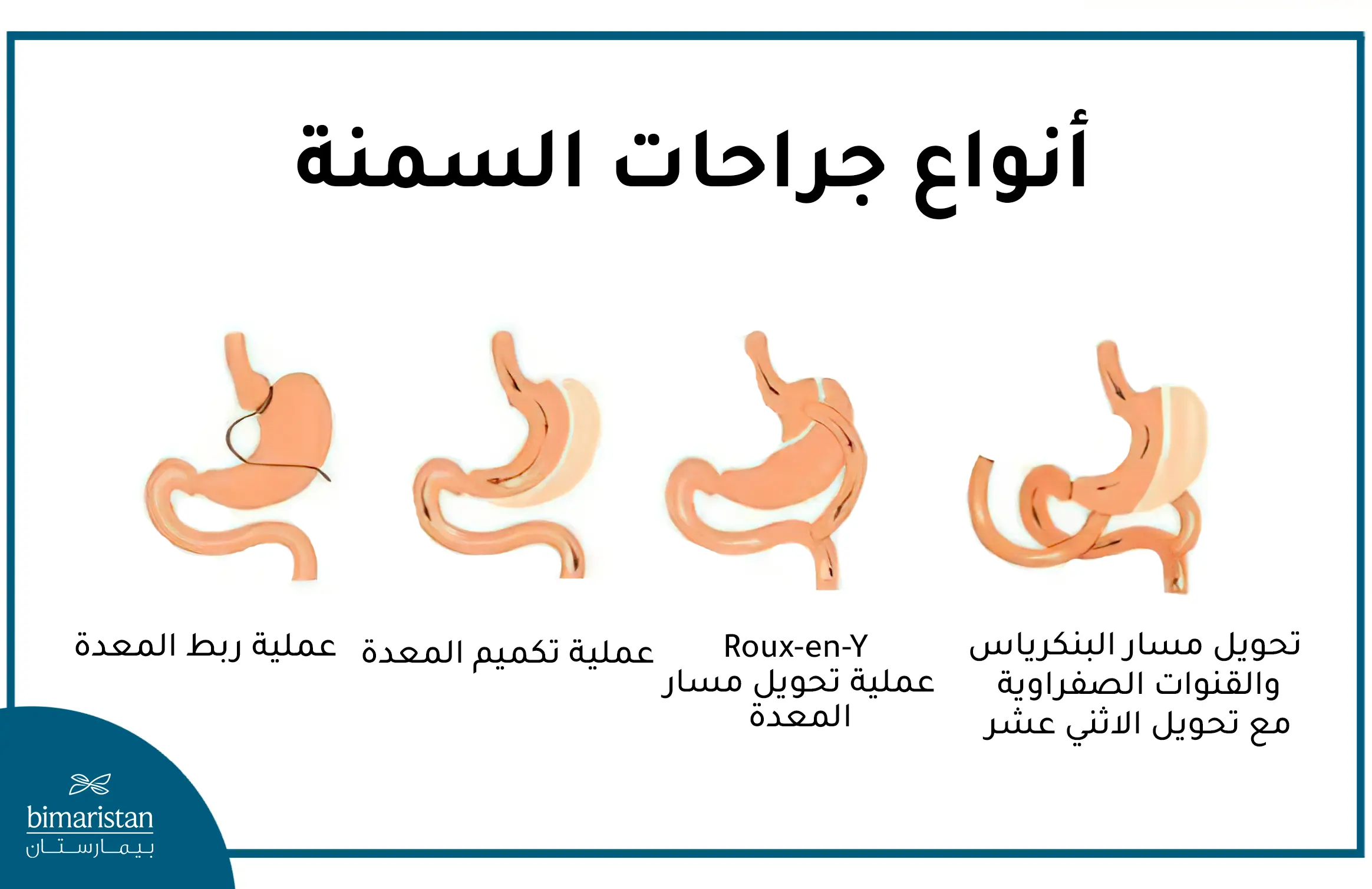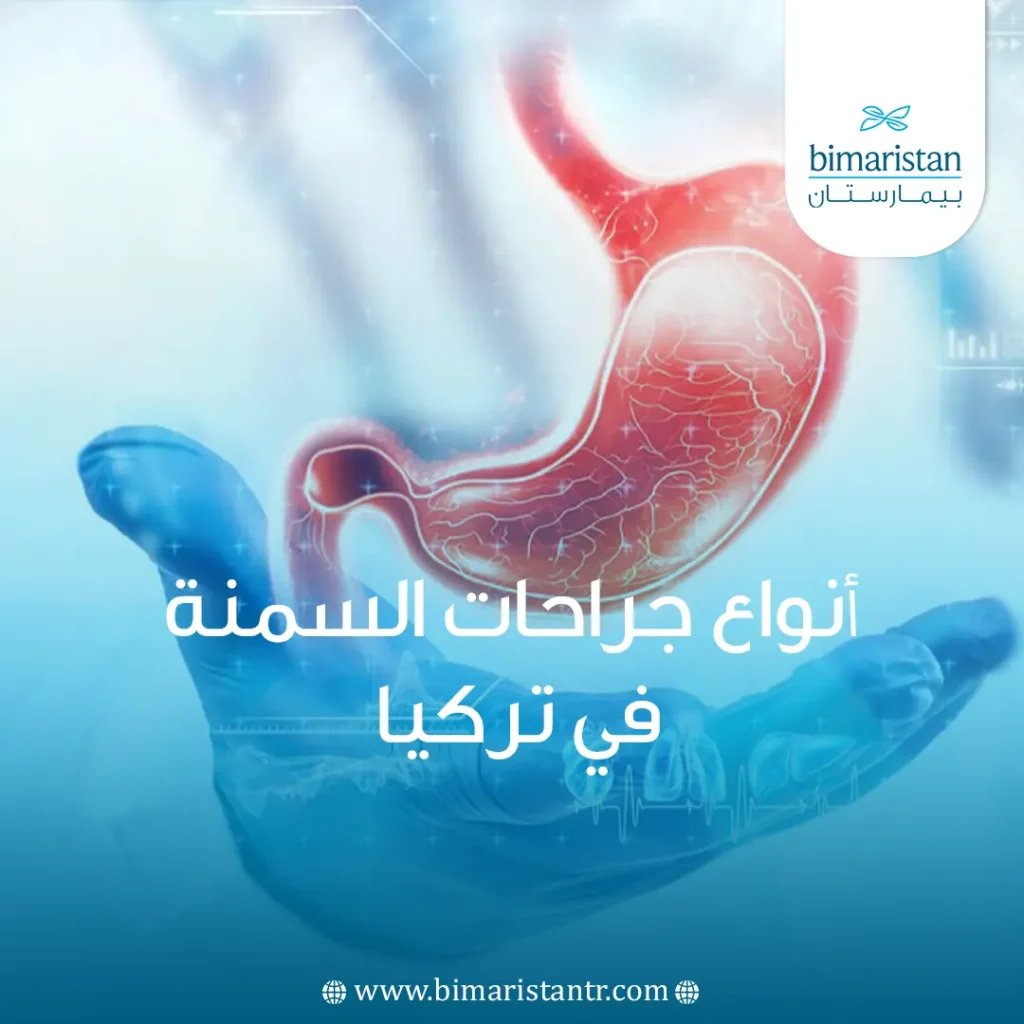مع تزايد الإصابة بالسمنة أصبحت عمليات إنقاص الوزن كثيرة الانتشار بطرقها المختلفة، لنتعرف على طرق علاج السمنة في تركيا مع مميزات وتكلفة كل طريقة.
يعاني أكثر من مليار شخص حول العالم من زيادة الوزن والبدانة بحسب إحصائيات منظمة الصحة العالمية في 2023، وترتبط البدانة مع أمراض القلب والسكري وارتفاع ضغط الدم بالإضافة لمشاكل نفسية كالاكتئاب وضعف الثقة بالنفس، لذلك عملت تركيا على توفير طرق جراحية لعلاج السمنة عند الأشخاص الذين يفشلون في فقدان وزنهم عبر الرياضة والحمية الغذائية.
تهدف جراحة السمنة Bariatric surgery لخسارة الوزن الزائد خلال وقت قصير وبدون عناء كبير مع النظام الغذائي الصارم والرياضة المجهدة، فعملية تكميم المعدة هي أحد الطرق الشائعة لعلاج السمنة في تركيا وكذلك تحويل المسار وربط المعدة بالمنظار وغيرها من العمليات التي سنذكرها بالتفصيل مع المقارنة بين مميزات كل عملية وسلبياتها، بالإضافة لتوفير حسم خاص لمرضانا الراغبين بتلقي العلاج، تابع معنا هذا المقال لتفاصيل أكثر.
كيف يتم علاج السمنة في تركيا؟
عمليات السمنة لها أنواع عدة تختلف فيما بينها بالطريقة والتكنيك الجراحي المتبع ومنها:
عملية التكميم في تركيا
تكميم المعدة Sleeve gastrectomy هي الإجراء الجراحي الأشيع على الإطلاق لعلاج السمنة حول العالم، تتم هذه الجراحة عن طريق تصغير حجم المعدة لأكثر من 80% من حجمها الطبيعي مما يؤدي إلى الشعور الباكر بالشبع وإنقاص الشهية للطعام وبالتالي فقدان الوزن مع مرور الوقت.
يمكن إجراء عملية قص المعدة باستخدام المنظار الجراحي طفيف التوغل مما يجعل هذه الجراحة آمنة لحدٍ كبير مع احتمال أقل لحدوث مضاعفات جانبية، كما أن نتائج هذه العملية تعتبر جيدة جداً حيث تقدر نسبة الوزن المفقود بحوالي 50 لـ 60% من وزن المريض الزائد خلال مدة تتراوح من 12 إلى 18 شهر بعد الإجراء، يمكنك القراءة أكثر عن عملية تكميم المعدة.
تحويل مسار المعدة
تطورت مؤخراً عملية مفاغرة المعدة (Roux-en-Y) حتى أصبحت واحدة من أشيع عمليات علاج السمنة في تركيا، تعتمد هذه الجراحة على إجراء تغييرات على المعدة والأمعاء الدقيقة بحيث يتم إنشاء جيب صغير بالمعدة عبر استئصال القسم العلوي مع بقاء القسم السفلي متصلاً مع الاثني عشر ومن ثم يستأصل جزء من الأمعاء الدقيقة وتوصل نهاية الإثنى عشر مع نهاية الأمعاء، ويتم تعديل الطريق الطبيعي الذي تصب فيه الصفراء والعصارات الهاضمة.
هذه الجراحة تساهم بالتنحيف عبر طريقين وهما سوء الامتصاص والطريق التقييدي (تكميم المعدة) لذلك فهي تعطي نتائج مميزة بفقدان الوزن تقدر وسطيًا بـ 60% من الوزن الزائد، للمزيد من المعلومات اضغط على عملية تحويل مسار المعدة.
عملية ربط المعدة
تجرى هذه العملية بالتنظير عبر وضع حلقة من السيليكون المملوء بسائل ملحي حول الجزء العلوي للمعدة مما يؤدي لضغط مدخل المعدة والإبقاء على منفذ صغير بعرض 2 سم لدخول الطعام وهذا يعطي شعور باكر بالشبع.
يمكن إرخاء رباط السيليكون وشده بحسب الحاجة وتعتبر هذه الطريقة كثيرة الاستخدام لمعالجة البدانة في تركيا فهي أقل خطراً من جراحة تحويل المسار والتكميم ولكنها تعتمد على إدخال جهاز خارجي وربطه بالمعدة، اقرأ المزيد عن ربط المعدة بالمنظار.
تغيير مجرى القنوات الصفراوية وتحويل الإثني عشر
تنطوي هذه العملية المعقدة BPD/DS على إزالة قسم من المعدة ومن ثم وصل القسم الأول من الأمعاء (الاثني عشر) مع القسم النهائي للمعي الدقيق (اللفائفي) بحيث يمكن اجتياز قسم كبير من المجرى الطبيعي للأمعاء مما يؤدي لإحداث سوء امتصاص للعناصر الغذائية ويساهم بآلية فقدان الوزن بالمشاركة مع تصغير مساحة المعدة.
هذه العملية هي الأفضل من حيث النتائج بين جراحات السمنة فقد تصل خسارة الوزن لأكثر من 70% من وزن المريض الزائد وهي مفضلة بشكل خاص لدى مرضى السكري ولكنها أكثر خطورة من عمليات السمنة الأخرى مما يجعلها قليلة الشيوع، يمكنك الحصول على معلومات أكثر عن جراحة تحويل مسار البنكرياس والقنوات الصفراوية.
مفاغرة مفردة مع تكميم المعدة
هذه الطريقة هي نسخة مشابهة لعملية تحويل الإثني عشر مع القيام ببعض التعديلات فيما يخص طريقة إجراء المفاغرة وذلك بهدف التقليل من خطورة العملية السابقة والوفيات المرتبطة بها وجعل الإجراء أقل تعقيداً مما سبق.
تم إجراء دراسة حديثة للمقارنة بين نتائج المفاغرة الأحادية للإثني عشر SADI-S وجراحة تحويل القنوات الصفراوية المشابهة لها.
احصل على تفاصيل أكثر عن الدراسة من هنا.
كبسولة بالون المعدة
تعتبر كبسولة المعدة المبرمجة للتنحيف أحد الأنواع المميزة لبالونات المعدة في تركيا، فهي عبارة عن كبسولة صغيرة قابلة للبلع يتم إدخالها للمعدة بدون جراحة أو تنظير وتتميز بنتائجها السريعة في تخفيف الوزن بالمقارنة مع جراحات السمنة.
اقرأ أكثر عن الكبسولة الذكية القابلة للبلع.
بوتوكس المعدة لعلاج السمنة في تركيا
تستخدم مادة البوتوكس بشكل شائع في عمليات التجميل وذلك لخصائصها المرخية للعضلات، وتم مؤخراً حقنها بالمعدة للمساهمة في تخفيف الوزن عبر إرخاء عضلات المعدة مما يسبب صعوبة دفع الطعام للأمعاء ومنه فإن المعدة تبقى ممتلئة لفترة أطول ويشعر المريض بالشبع باكراً عند تناوله لوجبة الطعام.
حقن بوتكس المعدة Gastric Botox من الإجراءات الحديثة في تركيا لعلاج السمنة بالتنظير وبدون القيام بعملية جراحية فهي قليلة الخطورة لكن ما يعيبها هو أن مفعول البوتكس يزول خلال فترة 6 أشهر ويمكن إعادة الحقن مجدداً.

نصائح حول عمليات علاج السمنة في تركيا
من المهم اتباع تعليمات الفريق الطبي خلال فترة التحضير قبل خضوعك للعملية وكذلك في مرحلة التعافي بعد الإجراء، إليك بعض النصائح فيما يتعلق بجراحات علاج السمنة:
- قم باختيار جراح خبير لإجراء جراحة السمنة
- ناقش الخيارات المطروحة مع طبيبك الأخصائي بخصوص الجراحة المناسبة
- تأكد من استعدادك للتأقلم مع نمط الحياة الذي يلي العملية
- التزامك بعيش حياة صحية بعد عمليتك يضمن لك نتائج أفضل وبوقت أقصر
- اسأل عن الحمية الغذائية المناسب وخطوات التعافي قبل إجرائك للجراحة
- توقع بشكل منطقي نتائج جراحة التنحيف لعدم الشعور بالإحباط لاحقاً
- كن على علم بالمخاطر المترتبة عن العملية وتأكد من اختيارك مركز متخصص حاصل على ترخيص من الدولة التركية
في حال رغبتك بإنقاص وزنك عبر إجراء عمل جراحي في تركيا يمكنك التواصل مع فريقنا المؤلف من أطباء عرب وأتراك وأخصائيين بالتغذية يساعدون المرضى خطوة بخطوة في رحلة تلقي العلاج مع الإجابة على كافة التساؤلات التي تراود ذهنك، يمكنك طلب استشارة مجانية عبر موقعنا الالكتروني أو من خلال الاتصال بنا.
تكلفة جراحات السمنة في تركيا
لعل من أبرز الأسباب التي تجعل تركيا وجهة علاجية للكثير من المرضى الراغبين بخسارة الوزن هو توفير أفضل المراكز المتخصصة والمجهزة بأحدث التقنيات الجراحية مع كادر طبي خبير بإجراء جراحات السمنة بأنواعها المختلفة، ولا ننسى أيضاً التكاليف المنخفضة مقارنة مع كثير من الدول المجاورة، ففي عام 2018 تم إجراء ما يقارب 18000 عملية جراحية لعلاج البدانة في تركيا، وقد ارتفعت هذه الأرقام لتصل إلى 40000 في السنة الأخيرة مما يشير إلى تطور كبير في مجال علاج السمنة الجراحي.
تختلف الأسعار من مركز لآخر بحسب طبيعة العمل الجراحي وحالة كل مريض، فتقدر تكلفة تكميم المعدة في تركيا بـ 2000 دولار أمريكي بينما تبلغ تكلفة تحويل مسار المعدة حوالي 4000 دولار وبالنسبة لعملية تدبيس المعدة بالمنظار فإن سعرها يبدأ من 700 دولار فقط، تواصل معنا لتفاصيل أكثر عن الأسعار ولإرشادك لأفضل المراكز التركية التي تقوم بإجراء جراحات تخفيف الوزن.
خدمات مركز بيمارستان لعلاج السمنة في تركيا
يقدم مركز بيمارستان خدماته العلاجية عبر تأمين إجراءات السفر للأشخاص الراغبين بتلقي العلاج في تركيا بدءاً من تأشيرات السفر ومروراً بالإقامة داخل الأراضي التركية مع تقديم استشارات طبية وحجز مواعيد عند أكثر الأطباء والجراحين شهرة في تركيا مع إبقاء التواصل مع المريض لحين العودة لبلده بعد انتهاء علاجه.
وختاماً فإن جراحات علاج السمنة أصبحت من العمليات الشائعة نظراً لانتشار البدانة بين عامة الناس، تتميز تركيا بتوفير كافة الوسائل المتاحة عالمياً لعلاج السمنة ضمن أحدث المستشفيات والمراكز المتخصصة وبأقل الأسعار الممكنة.
المصادر:

